北师大版(2019)必修 第三册Unit 9 Learning Lesson 1 Active Learning精品课件(共21张PPT)
文档属性
| 名称 | 北师大版(2019)必修 第三册Unit 9 Learning Lesson 1 Active Learning精品课件(共21张PPT) |  | |
| 格式 | pptx | ||
| 文件大小 | 6.5MB | ||
| 资源类型 | 教案 | ||
| 版本资源 | 北师大版(2019) | ||
| 科目 | 英语 | ||
| 更新时间 | 2023-03-07 21:54:18 | ||
图片预览

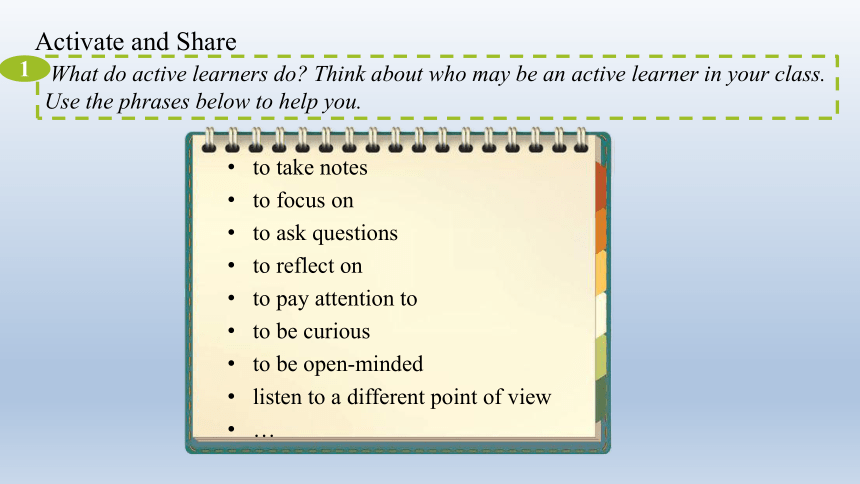

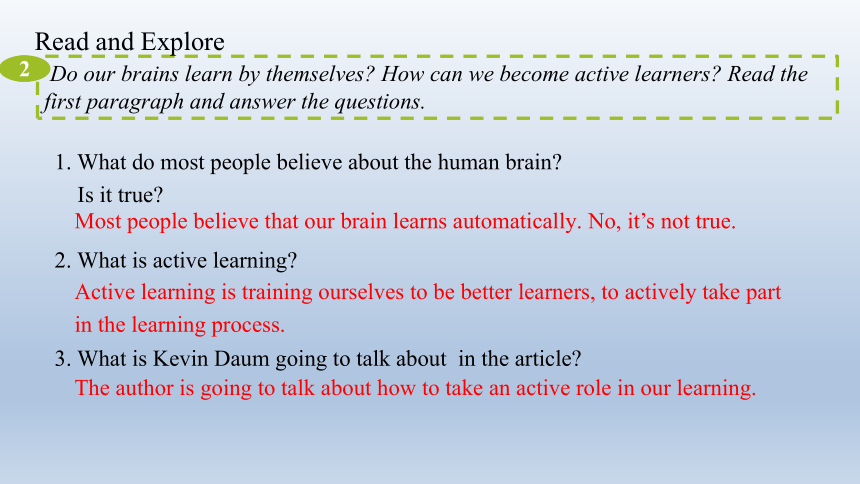
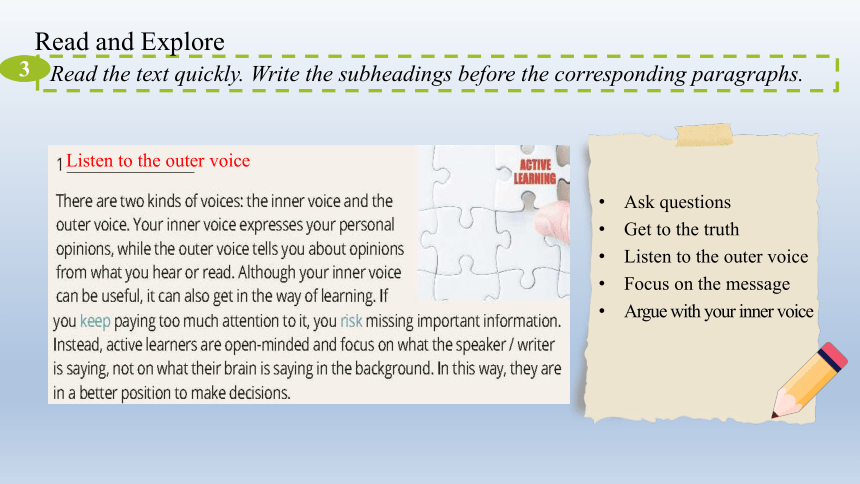

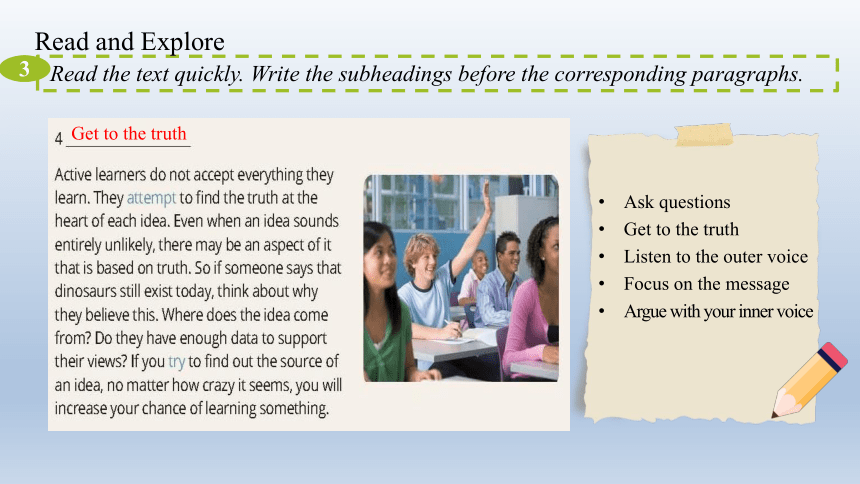

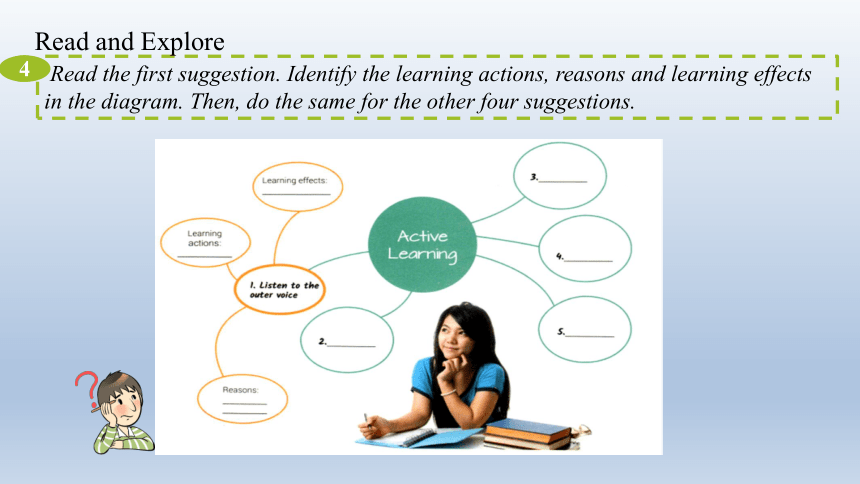
文档简介
(共21张PPT)
Unit 9 Learning
Lesson 1 Active Learning
What do active learners do Think about who may be an active learner in your class. Use the phrases below to help you.
Activate and Share
to take notes
to focus on
to ask questions
to reflect on
to pay attention to
to be curious
to be open-minded
listen to a different point of view
…
1
Do our brains learn by themselves How can we become active learners Read the first paragraph and answer the questions.
Read and Explore
1
2
Do our brains learn by themselves How can we become active learners Read the first paragraph and answer the questions.
Read and Explore
1. What do most people believe about the human brain
Is it true
2. What is active learning
3. What is Kevin Daum going to talk about in the article
Most people believe that our brain learns automatically. No, it’s not true.
Active learning is training ourselves to be better learners, to actively take part in the learning process.
The author is going to talk about how to take an active role in our learning.
2
2
Read the text quickly. Write the subheadings before the corresponding paragraphs.
Read and Explore
Ask questions
Get to the truth
Listen to the outer voice
Focus on the message
Argue with your inner voice
3
Listen to the outer voice
3
Read the text quickly. Write the subheadings before the corresponding paragraphs.
Read and Explore
Ask questions
Get to the truth
Listen to the outer voice
Focus on the message
Argue with your inner voice
3
Argue with your inner voice
Ask questions
3
Read the text quickly. Write the subheadings before the corresponding paragraphs.
Read and Explore
Ask questions
Get to the truth
Listen to the outer voice
Focus on the message
Argue with your inner voice
3
Get to the truth
3
Read the text quickly. Write the subheadings before the corresponding paragraphs.
Read and Explore
Ask questions
Get to the truth
Listen to the outer voice
Focus on the message
Argue with your inner voice
4
Focus on the message
3
Read the first suggestion. Identify the learning actions, reasons and learning effects in the diagram. Then, do the same for the other four suggestions.
Read and Explore
4
4
Read the first suggestion. Identify the learning actions, reasons and learning effects in the diagram. Then, do the same for the other four suggestions.
Read and Explore
4
Learning effects
Learning actions
Reasons
1. Listen to the outer voice
Be in a better position to make decisions
be open-minded and focus on what the speaker/writer is saying
If you keep paying too much attention to inner voice, you risk missing important information.
4
Read the first suggestion. Identify the learning actions, reasons and learning effects in the diagram. Then, do the same for the other four suggestions.
Read and Explore
4
Learning effects
Learning actions
Reasons
2. Argue with your inner voice
End up agreeing with the speaker/ writer or at least “listen to” another point of view
Think about why the speaker or writer may be right.
Inner voice is difficult to control.
4
Read the first suggestion. Identify the learning actions, reasons and learning effects in the diagram. Then, do the same for the other four suggestions.
Read and Explore
4
Learning effects
Learning actions
Reasons
3. Ask questions
Lead you to further learning, and help you to achieve a higher level of understanding about the topic
When getting information from others, books or the Internet, ask two, three or more questions about the topic.
It is easiest way to promote active learning.
4
Read the first suggestion. Identify the learning actions, reasons and learning effects in the diagram. Then, do the same for the other four suggestions.
Read and Explore
4
Learning effects
Learning actions
Reasons
4. Get to the truth
Increase chance of learning something.
Don’t accept everything you learn and find the truth at the heart of each idea.
Even when an idea sounds entirely unlikely, there may be an aspect of it that is based on truth.
4
Read the first suggestion. Identify the learning actions, reasons and learning effects in the diagram. Then, do the same for the other four suggestions.
Read and Explore
4
Learning effects
Learning actions
Reasons
5. Focus on the message
Even if you don’t like a person, you can learn from him.
Don’t judge a person by first impression. Separate the message from the messenger.
You may miss out on learning opportunities if you let your feelings get in the way.
4
Group work. Each student chooses one suggestion and introduces it to others.
Read and Explore
5
Your show!
5
Are the following ways of learning correct according to Kevin Daum. Write T (true) or F (false). If not, what should we do Why
Read and Explore
6
1. When in class, focus on the voice expressing your own opinion.
2. If you think a speaker is wrong, argue with him/her.
3. Be curious to find more information about the topic.
4. Believe what is said in books.
5. Only engage in classes of your favourite teacher’s.
F
F
F
T
F
be open-minded and focus on what the speaker/writer is saying.
think about why the speaker/writer may be right.
Find the truth at the heart of each idea.
Separate the message from the messenger. You can learn something from people you dislike.
6
Which of the suggestions in the text do you think is the most useful for you Why Do you have any questions about those suggestions
Read and Explore
7
Example
I think “argue with your inner voice” is the most useful, because it makes me consider the other side of an argument.
7
Read the summary. Use the phrases below to replace the underlined parts.
Read and Explore
8
in short based on at the heart of attempt to
argue with achieve a higher level of understanding get in the way of learning
There are many things we can do to become better learners. We all have two voices. Our inner voice tells us personal opinions and our outer voice deals with others’ opinions and things we have heard. If we listen to our inner voice too much, it can 1 block us from learning. If your inner voice is difficult to control, you can 2 disagree with it. One of the best ways to promote active learning is to ask questions. This helps you 3 gain more knowledge about a topic. 4 In a word, we should never stop being curious. Active learners also 5 try to question the world around them and understand the truth 6 deep within every idea. Finally, as active learners, we should never form opinions about people 7 on the basis of first impressions.
get in the way of learning
argue with
achieve a higher level of understanding
in short
attempt to
at the heart of
based on
8
Look at the coloured verbs in the article. Add the following verbs to the table.
Focus on Language
9
Verbs followed by verb-ing form Verbs followed by infinitive
suggest doing need to do
advise agree avoid can’t stand don’t mind enjoy start
help like manage practise regret seem remember
advise
agree
avoid
can’t stand
don’t mind
enjoy
start
start
help
like
like
manage
practise
regret
regret
seem
remember
remember
9
Complete the text with the correct form of the verbs in brackets.
Focus on Language
10
to become
to forget
concentrating
questioning
listening
to ask
What other ways of active learning do you know How will you learn actively in the future Make a list and explain them.
Homework
Unit 9 Learning
Lesson 1 Active Learning
What do active learners do Think about who may be an active learner in your class. Use the phrases below to help you.
Activate and Share
to take notes
to focus on
to ask questions
to reflect on
to pay attention to
to be curious
to be open-minded
listen to a different point of view
…
1
Do our brains learn by themselves How can we become active learners Read the first paragraph and answer the questions.
Read and Explore
1
2
Do our brains learn by themselves How can we become active learners Read the first paragraph and answer the questions.
Read and Explore
1. What do most people believe about the human brain
Is it true
2. What is active learning
3. What is Kevin Daum going to talk about in the article
Most people believe that our brain learns automatically. No, it’s not true.
Active learning is training ourselves to be better learners, to actively take part in the learning process.
The author is going to talk about how to take an active role in our learning.
2
2
Read the text quickly. Write the subheadings before the corresponding paragraphs.
Read and Explore
Ask questions
Get to the truth
Listen to the outer voice
Focus on the message
Argue with your inner voice
3
Listen to the outer voice
3
Read the text quickly. Write the subheadings before the corresponding paragraphs.
Read and Explore
Ask questions
Get to the truth
Listen to the outer voice
Focus on the message
Argue with your inner voice
3
Argue with your inner voice
Ask questions
3
Read the text quickly. Write the subheadings before the corresponding paragraphs.
Read and Explore
Ask questions
Get to the truth
Listen to the outer voice
Focus on the message
Argue with your inner voice
3
Get to the truth
3
Read the text quickly. Write the subheadings before the corresponding paragraphs.
Read and Explore
Ask questions
Get to the truth
Listen to the outer voice
Focus on the message
Argue with your inner voice
4
Focus on the message
3
Read the first suggestion. Identify the learning actions, reasons and learning effects in the diagram. Then, do the same for the other four suggestions.
Read and Explore
4
4
Read the first suggestion. Identify the learning actions, reasons and learning effects in the diagram. Then, do the same for the other four suggestions.
Read and Explore
4
Learning effects
Learning actions
Reasons
1. Listen to the outer voice
Be in a better position to make decisions
be open-minded and focus on what the speaker/writer is saying
If you keep paying too much attention to inner voice, you risk missing important information.
4
Read the first suggestion. Identify the learning actions, reasons and learning effects in the diagram. Then, do the same for the other four suggestions.
Read and Explore
4
Learning effects
Learning actions
Reasons
2. Argue with your inner voice
End up agreeing with the speaker/ writer or at least “listen to” another point of view
Think about why the speaker or writer may be right.
Inner voice is difficult to control.
4
Read the first suggestion. Identify the learning actions, reasons and learning effects in the diagram. Then, do the same for the other four suggestions.
Read and Explore
4
Learning effects
Learning actions
Reasons
3. Ask questions
Lead you to further learning, and help you to achieve a higher level of understanding about the topic
When getting information from others, books or the Internet, ask two, three or more questions about the topic.
It is easiest way to promote active learning.
4
Read the first suggestion. Identify the learning actions, reasons and learning effects in the diagram. Then, do the same for the other four suggestions.
Read and Explore
4
Learning effects
Learning actions
Reasons
4. Get to the truth
Increase chance of learning something.
Don’t accept everything you learn and find the truth at the heart of each idea.
Even when an idea sounds entirely unlikely, there may be an aspect of it that is based on truth.
4
Read the first suggestion. Identify the learning actions, reasons and learning effects in the diagram. Then, do the same for the other four suggestions.
Read and Explore
4
Learning effects
Learning actions
Reasons
5. Focus on the message
Even if you don’t like a person, you can learn from him.
Don’t judge a person by first impression. Separate the message from the messenger.
You may miss out on learning opportunities if you let your feelings get in the way.
4
Group work. Each student chooses one suggestion and introduces it to others.
Read and Explore
5
Your show!
5
Are the following ways of learning correct according to Kevin Daum. Write T (true) or F (false). If not, what should we do Why
Read and Explore
6
1. When in class, focus on the voice expressing your own opinion.
2. If you think a speaker is wrong, argue with him/her.
3. Be curious to find more information about the topic.
4. Believe what is said in books.
5. Only engage in classes of your favourite teacher’s.
F
F
F
T
F
be open-minded and focus on what the speaker/writer is saying.
think about why the speaker/writer may be right.
Find the truth at the heart of each idea.
Separate the message from the messenger. You can learn something from people you dislike.
6
Which of the suggestions in the text do you think is the most useful for you Why Do you have any questions about those suggestions
Read and Explore
7
Example
I think “argue with your inner voice” is the most useful, because it makes me consider the other side of an argument.
7
Read the summary. Use the phrases below to replace the underlined parts.
Read and Explore
8
in short based on at the heart of attempt to
argue with achieve a higher level of understanding get in the way of learning
There are many things we can do to become better learners. We all have two voices. Our inner voice tells us personal opinions and our outer voice deals with others’ opinions and things we have heard. If we listen to our inner voice too much, it can 1 block us from learning. If your inner voice is difficult to control, you can 2 disagree with it. One of the best ways to promote active learning is to ask questions. This helps you 3 gain more knowledge about a topic. 4 In a word, we should never stop being curious. Active learners also 5 try to question the world around them and understand the truth 6 deep within every idea. Finally, as active learners, we should never form opinions about people 7 on the basis of first impressions.
get in the way of learning
argue with
achieve a higher level of understanding
in short
attempt to
at the heart of
based on
8
Look at the coloured verbs in the article. Add the following verbs to the table.
Focus on Language
9
Verbs followed by verb-ing form Verbs followed by infinitive
suggest doing need to do
advise agree avoid can’t stand don’t mind enjoy start
help like manage practise regret seem remember
advise
agree
avoid
can’t stand
don’t mind
enjoy
start
start
help
like
like
manage
practise
regret
regret
seem
remember
remember
9
Complete the text with the correct form of the verbs in brackets.
Focus on Language
10
to become
to forget
concentrating
questioning
listening
to ask
What other ways of active learning do you know How will you learn actively in the future Make a list and explain them.
Homework
同课章节目录
- Unit 7 Art
- Lesson 1 Masterpieces
- Lesson 2 Beijing Opera
- Lesson 3 A Musical Genius
- Unit 8 Green living
- Lesson 1 Roots and Shoots
- Lesson 2 Greening the Desert
- Lesson 3 "White Bikes" on the Road
- Unit 9 Learning
- Lesson 1 Active Learning
- Lesson 2 Language Learning Tips
- Lesson 3 The Secrets of Your Memory
